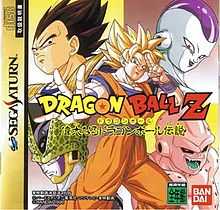Dragon Ball Z: Idainaru Dragon Ball Densetsu
| Dragon Ball Z: The Legend | |
|---|---|
 Sega Saturn's Japanese box art | |
| Developer(s) | Tose Software |
| Publisher(s) | Bandai |
| Series | Dragon Ball |
| Platform(s) | Sega Saturn PlayStation |
| Release date(s) | |
| Genre(s) | Fighting |
| Mode(s) | Up to 2 players simultaneously |
| Distribution | CD-Rom |
Dragon Ball Z: The Legend, known as Dragon Ball Z: Idainaru Dragon Ball Densetsu (ドラゴンボールZ 偉大なるドラゴンボール伝説 Doragon Bōru Zetto Idainaru Doragon Bōru Densetsu, Dragon Ball Z: The Greatest Dragon Ball Legend) in Japan, is a fighting game produced and released by Bandai on May 31, 1996 in Japan, released for the Sega Saturn and PlayStation.[1] Greatest Hits versions were released on June 20, 1997 for the Saturn and June 27, 1997 for the PlayStation. In Europe, only the Sega Saturn version was released in France and Spain on January 1, 1996,[1] with the French edition retaining the original Japanese name and the Spanish edition being re-addressed as Dragon Ball Z: The Legend.
Gameplay

The game utilizes a unique system of play that is different from most other fighters. The graphics feature 2-D sprites in a three dimensional world.[2] Although each battle begins on the ground, the majority of the action is featured skyward. The characters fly around each other and utilize rapid punches and kicks, and ki blasts, either singularly or rapidly by holding the assigned button for a short period. The characters have a limited amount of ki that can be charged over time. If the player uses all of their available ki their character will stop fighting out of exhaustion, leaving them wide open for an attack. The life meter is a scale made up of energy from both sides that shifts depending on damage taken, and after one side is depleted, the character performs a special "Meteo Attack", which takes place in a cut scene and finishes off the opponent.[2] Each match is made up of two teams that can include one fighter or multiple fighters (up to 3) that can be switched out at various times.[2]
The story mode of the game is divided into episodes, and it encompasses all of Dragon Ball Z, featuring the most important battles of the series.[3]
Reception
| — | PlayStation | Saturn |
|---|---|---|
| Gamekult | 8/10[4] | 8/10[5] |
| Jeuxvideo.com | 14/20[6] | 15/20[7] |
| Joypad | 80/100[8] | |
| Joypad | 81/100[9] | |
| Player One | 75/100[10] |
The game received average reviews. The Saturn's version is commonly considered as the best one.[3]
References
- ↑ 1.0 1.1 "Dragon Ball Z: Idainaru Dragon Ball Densetsu". VGChartz. Retrieved 3 September 2014.
- ↑ 2.0 2.1 2.2 "Dragon Ball games on Meristation" (in Spanish). p. 14. Retrieved 28 January 2014.
- ↑ 3.0 3.1 "Dragon Ball games on Meristation" (in Spanish). p. 15. Retrieved 28 January 2014.
- ↑ "Dragon Ball Z (PSOne)". Gamekult (in French). Retrieved 6 January 2012.
- ↑ "Dragon Ball Z (Saturn)". Gamekult (in French). Retrieved 6 January 2012.
- ↑ "Dragon Ball Z Legends (PSOne)". Jeuxvideo.com (in French). 18 February 2011. Retrieved 6 January 2012.
- ↑ "Dragon Ball Z Legends (Saturn)". Jeuxvideo.com (in French). 18 February 2011. Retrieved 6 January 2012.
- ↑ "Dragon Ball Z Legends review". Joypad (55): 62/63.
- ↑ "Dragon Ball Z Legends review". Joypad (83): 61.
- ↑ "Dragon Ball Z Legends review". Player One (69): 66/67.
| ||||||||||||||||||||||||||||||||||||||||||